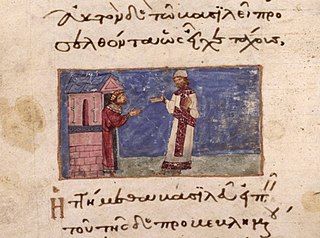
Eugenius was a Western Roman emperor from 392 to 394, unrecognized by the Eastern Roman emperor Theodosius I. While Christian himself, Eugenius capitalized on the discontent in the West caused by Theodosius' religious policies targeting pagans. He renovated the pagan Temple of Venus and Roma and restored the Altar of Victory after continued petitions from the Roman Senate. Eugenius replaced Theodosius' administrators with men loyal to him including pagans. This revived the pagan cause. His army fought the army of Theodosius at the Battle of the Frigidus, where he was captured and executed.

Praefectus, often with a further qualification, was the formal title of many, fairly low to high-ranking, military or civil officials in the Roman Empire, whose authority was not embodied in their person but conferred by delegation from a higher authority. They did have some authority in their prefecture, such as controlling prisons and in civil administration.
The Battle of the Utus was fought in 447 between the army of the Eastern Roman Empire, and the Huns led by Attila at Utus, a river that is today the Vit in Bulgaria. It was the last of the bloody pitched battles between the Eastern Roman Empire and the Huns, as the former attempted to stave off the Hunnic invasion.

The praefectus urbanus, also called praefectus urbi or urban prefect in English, was prefect of the city of Rome, and later also of Constantinople. The office originated under the Roman kings, continued during the Republic and Empire, and held high importance in late Antiquity. The office survived the collapse of the Western Roman Empire, and the last urban prefect of Rome, named Iohannes, is attested in 599. In the East, in Constantinople, the office survived until the 13th century.

Anthemius was a statesman of the Later Roman Empire. He is notable as a praetorian prefect of the East in the later reign of Arcadius and the first years of Theodosius II, during which time he led the government of the Eastern Roman Empire on behalf of the child emperor and supervised the construction of the first set of the Theodosian Walls.

The praetorian prefecture of the East, or of the Orient was one of four large praetorian prefectures into which the Late Roman Empire was divided. As it comprised the larger part of the Eastern Roman Empire, and its seat was at Constantinople, the praetorian prefect was the second most powerful man in the East, after the Emperor, in essence serving as his first minister.
Quintus Clodius Hermogenianus Olybrius was a Roman politician, praefectus urbi of Rome from 368 to 370 and Roman consul in 379. Olybrius has been characterized as belonging to "the breed of flexible politicians who did well both under Valentinian I [...] and under Gratian."
Vettius Agorius Praetextatus was a wealthy pagan aristocrat in the 4th-century Roman Empire, and a high priest in the cults of numerous gods. He served as the praetorian prefect at the court of Emperor Valentinian II in 384 until his death that same year.
Pusaeus was a politician of the Roman Empire.
Adamantius was a politician of the Eastern Roman Empire, praefectus urbi of Constantinople (474–479), patricius and honorary consul.
Flavius Florentius was a prominent high official of the Eastern Roman Empire, who influenced imperial policy during the second quarter of the fifth century.
Aurelianus was a prominent politician of the Eastern Roman Empire. He was praefectus urbi of Constantinople from 393 to 394, Praetorian prefect of the East from 399 to 400, and consul in 400. In 400, Gothic rebels under Gainas forced the emperor Arcadius to give them Aurelianus, and he was exiled; he returned to Constantinople after the defeat of the Goths later that year. He served as Pretorian Prefect to the East a second time from 414 to 416.
Flavius Anthemius Isidorus was a politician of the Eastern Roman Empire, the maternal uncle of the Western emperor Anthemius.
Flavius Caesarius was a politician of the Eastern Roman Empire, who served under the emperors Theodosius I and Arcadius. Caesarius was magister officiorum (386-387), praetorian prefect of the East, and consul in 397.
Flavius Eutolmius Tatianus was a Senator of the Late Roman Empire. Born in Sidyma, Lycia, by the 360s Tatianus was governor of the Thebaid. He governed Egypt, from 370 was comes Orientis, and from 374 was comes sacrarum largitionum. In 388 he was appointed Praetorian prefect of the East, and in 392 was removed from that role and arrested; he was later exiled.
Hilarius was a politician of the Western Roman Empire.

Domitius Modestus was a politician of the Roman Empire. He held appointments under the emperors Constantius II, Julian, and Valens, and was consul in 372. Previously a pagan, he converted to Arianism under Valens, and was sent by Valens to mediate between the Arian and Nicene factions with Basil of Caesarea.
Flavius Neoterius was a politician of the Roman Empire. He served as Praetorian prefect of the East, of Italy, and of Gaul. In 390 he was co-consul with Valentinian II.
Aetius was a politician of the Eastern Roman Empire, praefectus urbi of Constantinople and praetorian prefect of the East.
Ulpius Limenius was a Roman politician who was appointed consul in AD 349.